|
|
|
Sort Order |
|
|
|
Items / Page
|
|
|
|
|
|
|
| Srl | Item |
| 1 |
ID:
169876
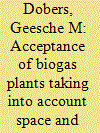

|
|
|
|
|
| Summary/Abstract |
As part of Germany's energy transition, enormous efforts are being made to transform the German energy supply to renewable energies. While much of the energy supply from renewables is wind and solar power, biogas contributes on third position a considerable share due to substantial state subsidies. The transformation to renewable energies leads to notable landscape changes that should be taken into consideration when studying the acceptance of renewable energy plants. We do this by adding spatial information to data from an online survey (N = 942) questioning the acceptance of biogas plants. The density of and proximity to existing biogas plants as well as the intensity of maize cultivation in the vicinity of respondents is integrated into the analysis together with more conventional influencing factors such as place attachment and attitudes. Results show that attitudes have the strongest explanatory power but spatial variables, particularly maize intensity, contribute significantly, too. Place attachment does not show reliable effects. The results demonstrate that spatial data can be useful in the analysis of survey data, for instance, in an environmental context. They also show that diversification of the raw materials used for fermentation in biogas plants might be an important factor in improving their acceptance.
|
|
|
|
|
|
|
|
|
|
|
|
|
|
|
|
| 2 |
ID:
112254


|
|
|
|
|
| Publication |
2012.
|
| Summary/Abstract |
The current status and legal framework of biogas production in Portugal are analyzed and compared to that of five other European countries, characterized by wide-ranging diversity of substrates and biogas applications. With this comparison, and with the calculation of the biogas energy potential in Portugal, the authors want to assess the significance of developing the Portuguese biogas sector. This study illustrates that the highest biogas feed-in tariffs are applied in the countries with a more developed sector. In Portugal, despite the fact that the organic effluents are a relevant energy source (873 Mm3 biogas per year; 4889 GW h yr-1) and that new feed-in tariffs were established, biogas valorisation is still at an early stage. The importance of anaerobic digestion was only recognized in 2007 and the present installed power is about 10% of the potential electrical power (229 MW). Therefore, it is desirable to strengthen the national and regional biogas market.
|
|
|
|
|
|
|
|
|
|
|
|
|
|
|
|
| 3 |
ID:
142586


|
|
|
|
|
| Summary/Abstract |
Biotechnological resource extraction methods such as biomining and biogas production could fill a vital niche in currently proposed ways for extracting minerals and producing fuel on asteroids. Well established on Earth, biomining applications on asteroids could significantly increase the output and efficiency of minerals processing. Biogas production, unlike conventional fuel extraction processes, relies on the presence of carbonaceous chondrite on asteroids. Bacteria placed on or within the asteroid would ferment these carbon sources and methanogenic Archaea would produce methane for spacecraft propulsion and industrial applications. Supporting microbial communities in space requires a thorough understanding of the limitations of microbial life, interacting environmental parameters as well as factors such as asteroid structure and nutrient availability. This paper examines engineering and ecological principles required to support an asteroid based microbial community. In addition socioeconomic factors such as current space policy and potential economic prospects are also discussed. Biotechnology is increasingly filling a niche in conventional engineering; with the advent of a new era in space, evolving these technologies is vital to fully developing humanity's space faring capabilities.
|
|
|
|
|
|
|
|
|
|
|
|
|
|
|
|
| 4 |
ID:
132833
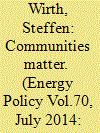

|
|
|
|
|
| Publication |
2014.
|
| Summary/Abstract |
Energy transitions are high on political agendas. From a practical viewpoint, community approaches are deemed essential in order to transition from a predominantly centralized energy supply to a decentralized one, and to exploit the potential of renewable energies. In this paper, I discuss how the emergence of community-based energy projects can be analyzed from an institutional perspective. In this context, a 'community' is treated as an individual institutional order that shapes decisions. I examine how community structures the implementation of biogas cooperatives in the Autonomous Province of South Tyrol in Northern Italy. My findings suggest that 'community spirit', a cooperative tradition, and the norms of locality and responsibility are central drivers behind the emergence and constitution of biogas cooperatives. Not only do these institutional features of community influence the decision concerning which farmers are in or out but also plant location and scale. I argue that 'community' is a necessary analytical category for understanding community energy.
|
|
|
|
|
|
|
|
|
|
|
|
|
|
|
|
| 5 |
ID:
136229


|
|
|
|
|
| Summary/Abstract |
Italy has witnessed an extraordinary growth in biogas generation from livestock effluents and agricultural activities in the last few years as well as a severe isomorphic process, leading to a market dominance of 999 kW power plants owned by “entrepreneurial farms”. Under the pressure of the economic crisis in the country, the Italian government has restructured renewable energy support schemes, introducing a new program in 2013. In this paper, the effects of the previous and current support schemes on the optimal plant size, feedstock mix and profitability were investigated by introducing a spatially explicit biogas supply chain optimization model, which accounts for different incentive structures. By applying the model to a regional case study, homogenization observed to date is recognized as a result of former incentive structures. Considerable reductions in local economic potentials for agricultural biogas power plants without external heat use, are estimated. New plants are likely to be manure-based and due to the lower energy density of such feedstock, wider supply chains are expected although optimal plant size will be smaller. The new support scheme will therefore most likely eliminate past distortions but also slow down investments in agricultural biogas plants.
|
|
|
|
|
|
|
|
|
|
|
|
|
|
|
|
| 6 |
ID:
129917
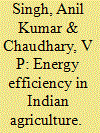

|
|
|
| 7 |
ID:
103489


|
|
|
|
|
| Publication |
2011.
|
| Summary/Abstract |
Gaseous biofuels including biomethane, which has been shown to be more environmentally beneficial than liquid biofuels, should contribute to meeting the challenging UK targets set for the supplying of biofuels to the road transport fuel market. Under the Renewable Transport Fuel Obligations the financial incentives for the supply of biofuels have been volatile, e.g. 2008/2009 saw Renewable Transport Fuel Certificate values fall to zero. Any shortfall from the maximum value has significant implications for all biofuels. It is demonstrated that biomethane can be produced at a cost which is competitive with liquid biofuels and fossil fuels within the UK. Technologies such as water scrubbing, pressure swing adsorption and physical and chemical absorption are available to upgrade biogas generated by anaerobic digestion of organic wastes to transport fuel quality, and technologies such as membrane separation and cryogenic distillation are being modified for such an application. The manufacture and sale of biomethane as a transport fuel is also financially competitive with Combined Heat and Power. One limiting factor may be the additional cost of purchasing and maintaining biomethane fuelled vehicles. Support in this area could lead to the rapid expansion of biomethane transport fuel infrastructure and bring significant long term environmental and economic advantages.
|
|
|
|
|
|
|
|
|
|
|
|
|
|
|
|
| 8 |
ID:
166720
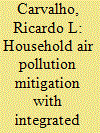

|
|
|
|
|
| Summary/Abstract |
Traditional cooking is today's largest global environmental health risk. Over 640 million people in Africa are expected to rely on biomass for cooking by 2040. In Kenya, cooking inefficiently with wood and charcoal persists as a cause of deforestation and household air pollution. This research analyses the effects of four biomass cookstove strategies on reducing air pollutant emissions in Kisumu County between 2015 and 2035 using the Long-Range Energy Alternatives Planning system. The Business as Usual scenario (BAU) was developed considering the historical trends in household energy use. Energy transition scenarios to Improved Cookstoves (ICS), Pellet Gasifier Stoves (PGS) and Biogas Stoves (BGS) were applied to examine the impact of these systems on energy savings and air pollution mitigation. An integrated scenario (INT) was evaluated as a mix of the ICS, PGS and BGS. The highest energy savings, in relation to the BAU, are achieved in the BGS (30.9%), followed by the INT (23.5%), PGS (19.4%) and ICS (9.2%). The BGS offers the highest reduction in the GHG (37.6%), CH4 (94.3%), NMVOCs (85.0%), CO (97.4%), PM2.5 (64.7%) and BC (48.4%) emissions, and the PGS the highest reduction in the N2O (83.0%) and NOx (90.7%) emissions, in relation to the BAU.
|
|
|
|
|
|
|
|
|
|
|
|
|
|
|
|
| 9 |
ID:
166541
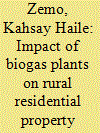

|
|
|
|
|
| Summary/Abstract |
In this paper, we investigate the impact of large- and farm-scale biogas plants on the rural residential property values. We use data from 11,279 rural housing transactions in the period 2007–2015 and trace spatial effects of biogas plants on the local property market. Our results show that large biogas plants have a significant negative impact on rural residential property values while farm-scale biogas plants have a significant positive impact. The findings suggest that preferences for or against biogas plants cannot be explained by either a NIMBY or a PIMBY phenomenon and the paper explores potential reasons for the observed disparity in valuation of farm- and large-scale biogas plants. An economic impact assessment of the choice of facility type, based on a concrete case study, indicates that the impact on residential property values may tip the scale in favor of farm-scale biogas plants. Based on these results, policy implications for planning and expansion of biogas production are discussed.
|
|
|
|
|
|
|
|
|
|
|
|
|
|
|
|
| 10 |
ID:
125839
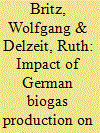

|
|
|
|
|
| Publication |
2013.
|
| Summary/Abstract |
As part of its climate policy, Germany promotes the production of biogas via its so-called Renewable-Energy-Act (EEG). The resulting boost in biogas output went along with a significant increase in production of green maize, the dominant feedstock. Existing studies of the EEG have analysed its impacts on German agriculture without considering market feedback. We thus expand existing quantitative analysis by also considering impacts on European and global agricultural markets, land use and the environment by combining a detailed location model for biogas plants, the Regionalised Location Information System-Maize (ReSi-M2012), with a global Partial Equilibrium model for agriculture, the Common Agricultural Policy Regional Impact (CAPRI) model. Our results indicate that the German biogas production is large enough to have sizeable impacts on global agricultural markets in prices and quantities, causing significant land use change outside of Germany. While profits in the agricultural sector increase, food consumer face higher prices, and subsidies for biogas production are passed on to electricity consumers. The German biogas program, as long as it is almost entirely based on non-waste feedstocks, is probably not a promising avenue towards a GHG-saving renewable energy production, but a rather expensive one.
|
|
|
|
|
|
|
|
|
|
|
|
|
|
|
|
| 11 |
ID:
133039


|
|
|
|
|
| Publication |
2014.
|
| Summary/Abstract |
The Indian Government's National Biogas and Manure Management Programme (NBMMP) seeks to deliver renewable energy services to households across the country by facilitating the deployment of family-sized (<6 m3) anaerobic (biogas) digesters. NBMMP policy is implemented at three levels, from government and state nodal agency, via private contractors to households, creating multiple institutional arrangements. We analysed the scheme in Assam, north-east India, focusing on how policy was implemented across two districts and interviewing stakeholders in rural households, state and non-state institutions. The top-down, supply-side approach to policy enables government to set targets and require individual states to deploy the scheme, which benefits households who can afford to participate. NBMMP delivered improved energy service outcomes to a majority of households, although the level of knowledge and understanding of the technology amongst users was limited. Training and education of householders, and particularly women, is needed in relation to the maintenance of digesters, feedstock suitability and the environmental and potential livelihood benefits of digestate. A revised bottom-up approach to policy, which highlights the contextual and demand-side issues around adopting the technology, may deliver monetary benefits from market competition and enable development of community-focused microfinance schemes to improve the affordability of biogas systems.
|
|
|
|
|
|
|
|
|
|
|
|
|
|
|
|
| 12 |
ID:
125581


|
|
|
|
|
| Publication |
2013.
|
| Summary/Abstract |
After the Swiss government's decision to decommission its five nuclear power plants by 2035, energy production from wind, biomass, biogas and photovoltaic is expected to increase significantly. Due to its many aspects of a direct democracy, high levels of public acceptance are necessary if a substantial increase in new renewable energy power plants is to be achieved in Switzerland. A survey of 502 citizens living near 19 biogas plants was conducted as the basis for using structural equation modeling to measure the effects of perceived benefits, perceived costs, trust towards the plant operator, perceived smell, information received and participation options on citizens' acceptance of "their" biogas plant. Results show that local acceptance towards existing biogas power plants is relatively high in Switzerland. Perceived benefits and costs as well as trust towards the plant operator are highly correlated and have a significant effect on local acceptance. While smell perception and information received had a significant effect on local acceptance as well, no such effect was found for participation options. Reasons for the non-impact of participation options on local acceptance are discussed, and pathways for future research are presented.
|
|
|
|
|
|
|
|
|
|
|
|
|
|
|
|
| 13 |
ID:
126474


|
|
|
|
|
| Publication |
2013.
|
| Summary/Abstract |
Small scale, decentralised electricity generation at village level, based on locally available biomass, is a promising solution for providing electricity access in remote rural areas, as it can supply villages with an independent, reliable, high quality and environmentally friendly energy source. However, despite such systems' technological feasibility, they are often discontinued. Research so far has not studied the reasons for discontinuation. This article analyses a case of biomass based gasification in India, by studying the type of goods the village system provides, and the distribution of benefits within the system. In this case, the infrastructural and social system provide electricity as a "club good". Given fluctuating numbers of service users, the club faced the decision to either expand the system to new members, or to reduce the services provided. The focus on the village community hampered the extension of "the club". A reduction in the quality and quantity of services however decreased the comfort provided by the system. The system faced what here is called a "club dilemma". To avoid the "club dilemma" and for a sustained energy provision, policy needs to find means to secure feedstock, i.e. by the means of subsidies or collaboration with agricultural departments.
|
|
|
|
|
|
|
|
|
|
|
|
|
|
|
|
| 14 |
ID:
178820


|
|
|
|
|
| Summary/Abstract |
Replacing natural gas with biomethane is an option to help decarbonize residential heating and cooling. But little biomethane is in the voluntary markets for heating. We examined biomethane-based gas tariff offerings in the UK, Germany, Austria and Switzerland, using qualitative content analysis and compared them to the national policy contexts. We find that current policies in all four countries under review clearly prioritize using biomethane for electricity generation and in transport, while leaving the heating market largely unregulated. Nonetheless, we find influence of policies on the heating market. Offerings in Germany show this influence in their biomethane content and underlying feedstock and in Austria regionality seems to be driven by grid charge regulations. If German policy makers want to channel more biomethane into residential heating, they are advised to harmonize competing support schemes for biomethane in electricity generation, transport and heating/cooling, waive mandatory CHP requirements, lower minimum biomethane content and to target existing, not just new, buildings. In the UK, the RHI should include residential buildings and using the Austrian refund system could help to develop biomethane tariffs from regional sources in Switzerland.
|
|
|
|
|
|
|
|
|
|
|
|
|
|
|
|
| 15 |
ID:
149854


|
|
|
|
|
| Summary/Abstract |
Energy plays a crucial role in economic development. The article presents a framework for the analysis of alternative energy technology mixes in agricultural production and applies it in the context of sisal production in the Tanga region, Tanzania. Through scenario analysis, the paper presents both case-specific and generalizable insights. Case-specific insights show the key role that modern uses of energy and modern agricultural technologies could play in increasing productivity and revenues, in minimizing environmental degradation, and in promoting local development. Generalizable insights demonstrate the value of using sector-specific micro-structural frameworks and scenario analysis for assessing different technologies mixes in the energy and agriculture planning process.
|
|
|
|
|
|
|
|
|
|
|
|
|
|
|
|
| 16 |
ID:
138381
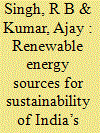

|
|
|
|
|
| Summary/Abstract |
The domestic production of crude oil from fossil fuels remains more or less stagnant over the years and meets only one third of national requirement, while the balance is met through imports of crude petroleum products that cost huge for the country close to $90 billion in 2008-09, which have massive impact on the country’s foreign exchange reserves.
|
|
|
|
|
|
|
|
|
|
|
|
|
|
|
|
| 17 |
ID:
109639


|
|
|
|
|
| Publication |
2011.
|
| Summary/Abstract |
This article presents an overview of the development and future perspectives of the Chinese biogas industry. The development of the industry has the potential to improve the rural environment and produce significant amounts of sustainable energy for China. Barriers to the development are the relatively weak environmental policies, imperfect financial policies and lack of long-term follow-up services. The rapid economic development of China has also seen a development in the scales of biogas plants constructed. Although the technology has been improved, this review has identified problems in the construction and operation of Chinese biogas plants, particularly in the efficiency of household systems. All levels of China's government acknowledge this and recent biogas projects have more focus on quality and less on the quantity. The intention is to gradually introduce stricter environmental policies, to provide better service systems, improve the financial policies that support the construction and follow-up service of biogas projects, promote the use of standardized engineering equipment and materials and standards for plant construction and production. This will promote the development of biogas projects at various scales further, and reduce the dependency on fossil fuels and emissions of greenhouse gases.
|
|
|
|
|
|
|
|
|
|
|
|
|
|
|
|
| 18 |
ID:
126473
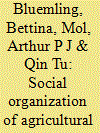

|
|
|
|
|
| Publication |
2013.
|
| Summary/Abstract |
While for wind, solar energy or hydropower, energy supply happens directly from the source to the wind wheels, hydropower turbines or solar panels, in the case of biogas, energy production cannot directly take from the energy source, organic matter, but depends on the institutional structures and farmers' practices involved for making energy available. With the production of bioenergy in rural areas, practices within agriculture are transformed, requiring new ways of organizing production processes. Research has left the question largely unanswered of how agricultural biogas production and use are - and can best be - organized within rural society. Which kinds of social organization exist, how are these embedded in existing agricultural institutions and practices, and how do these systems function? Under which conditions may the different kinds of social organization of biogas production and use work sustainably? This introduction article to the Special Issue "The social organization of agricultural biogas production and use" presents a framework for analysing the different kinds of social organization of biogas production and use presented hereafter. Analysis parameters are the supply network, distribution network, distribution of benefits, social boundaries of the system (accessibility) and scale. Using these parameters, the Special Issue articles are outlined.
|
|
|
|
|
|
|
|
|
|
|
|
|
|
|
|
| 19 |
ID:
126475


|
|
|
|
|
| Publication |
2013.
|
| Summary/Abstract |
The Chinese government since 1995 has carried out programs for the construction of household biogas digesters in the Chinese countryside. Despite the large governmental spending in the building of household biogas digesters, only 12.16% of the households suitable to produce and use biogas, have built a digester (Li, 2009). This article asks which factors on the household level may be important for the decision whether or not to build a biogas digester. Based on a survey with 1227 households from Guangxi, Hubei, Shandong and Gansu provinces, results of a binary Probit Model show that the governmental promotion of biogas has a significant effect on households' decision. The question arises which households may, if governmental programs were to be running out, be most likely to construct a household biogas digester? The household head's age, the number of household members staying at home, the total household income and the subjective discount rate of the respondents are significant factors in a farm household's decision to build a biogas digester. However, also agro-climatic conditions reveal to be decisive, which is why technical solutions for tackling the low productivity of biogas digesters in cold regions may need to be further considered.
|
|
|
|
|
|
|
|
|
|
|
|
|
|
|
|
|
|
|
|
|